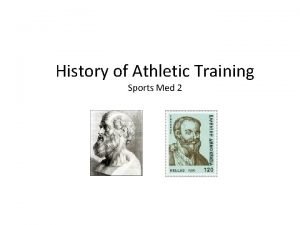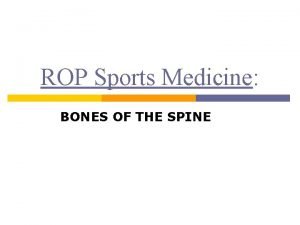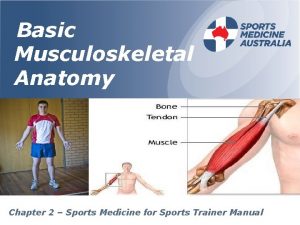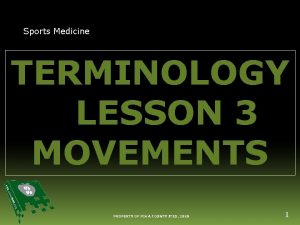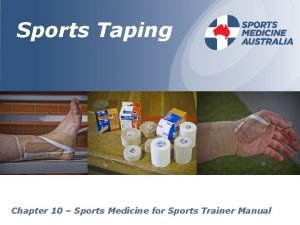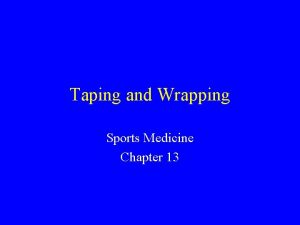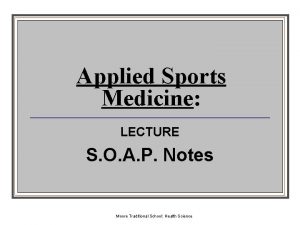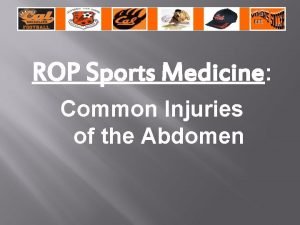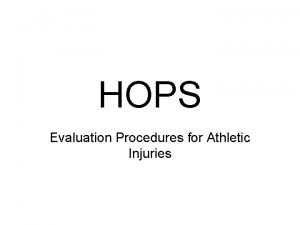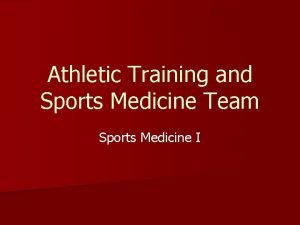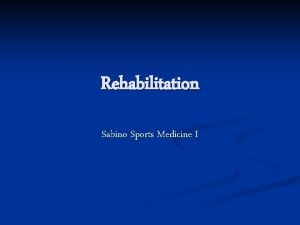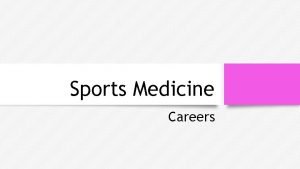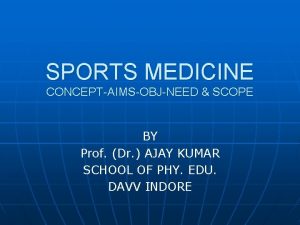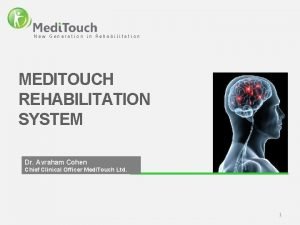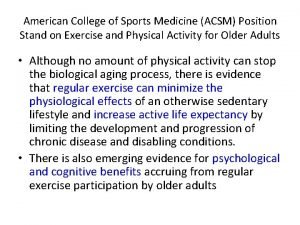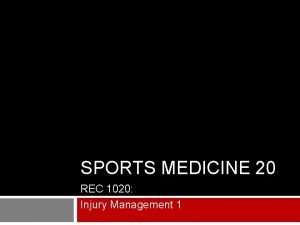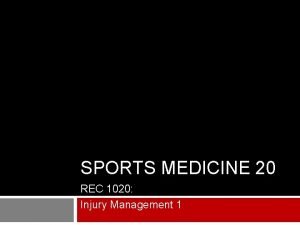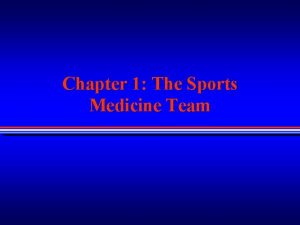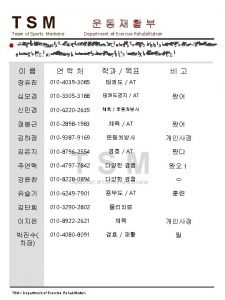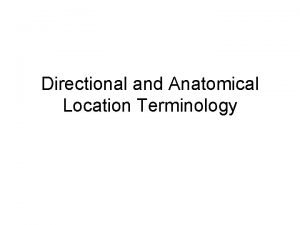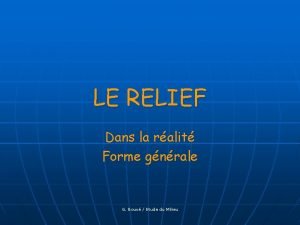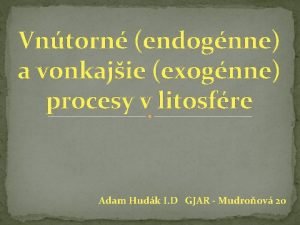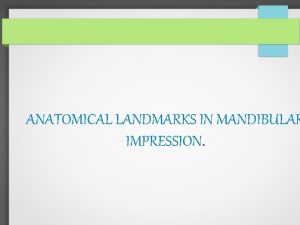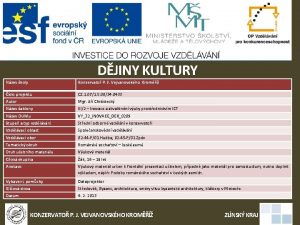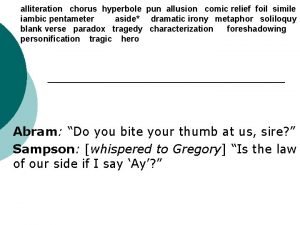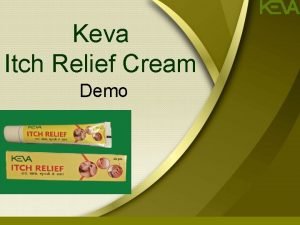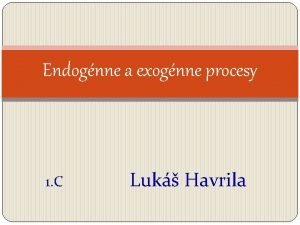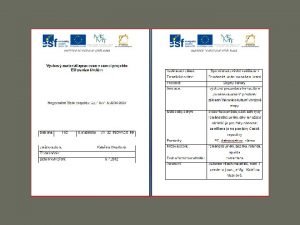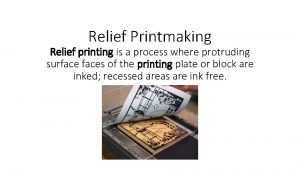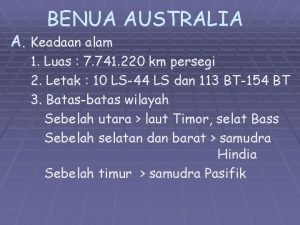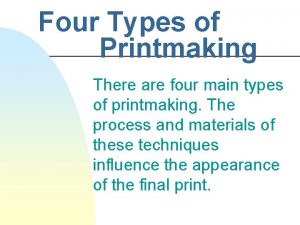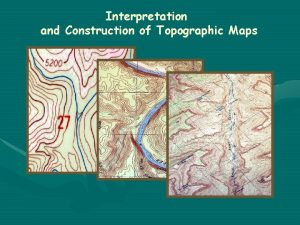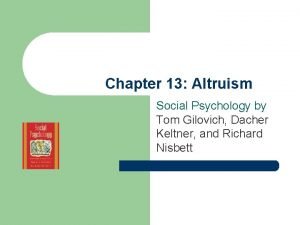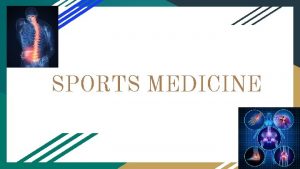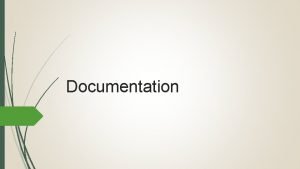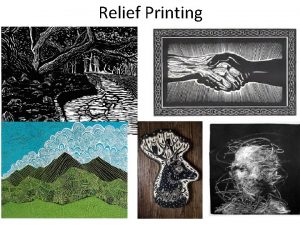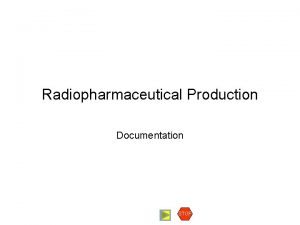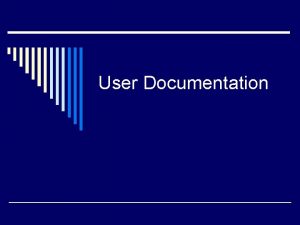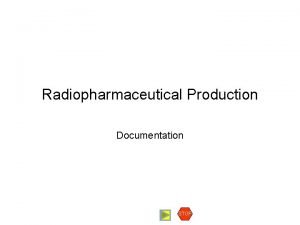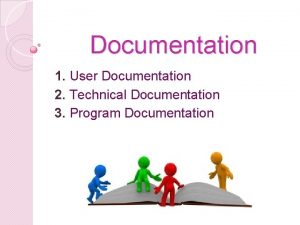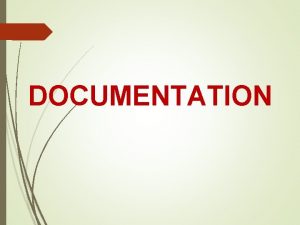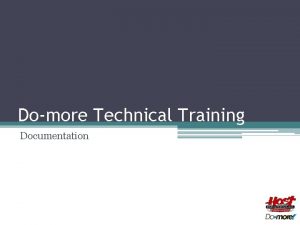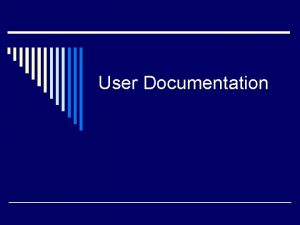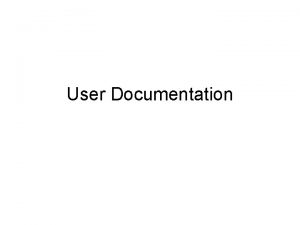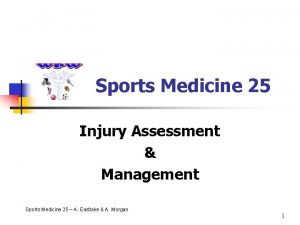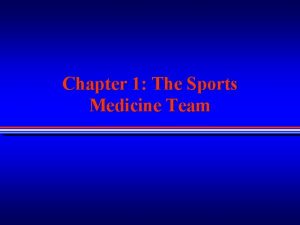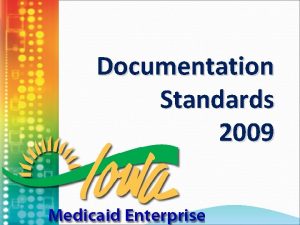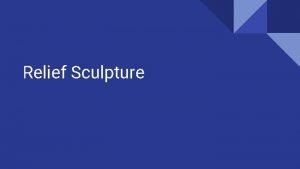DOCUMENTATION IN SPORTS MEDICINE Sports Medicine Goals Relief




















































- Slides: 52

DOCUMENTATION IN SPORTS MEDICINE!

Sports Medicine Goals Relief of pain Post surgical Medical problems Muscle strength and mobility Improvement Basic function Improvement Standing Walking Grasping

Parts of The Paper Trail 1. Assessment 1. The Examination 2. The Evaluation 2. 3. 4. 5. Diagnosis Prognosis Intervention/Treatment Re-Examination

3 Components of the Examination/Documentation Patient/Client Medical History Systems Review Tests and measures

Examination: History/Current Health Status Medical Background Age Medications Cognitive status Medical History Etiology of injury or illness Event leading to problem Co-morbities (for example low back pain would be Arthritis, osteoporosis, lack of exercise, stress level, poor self rated health, dissatisfaction with work) Duration of problem Clinical Assessments Muscle Strength & ROM Reflex Assessment

Examination: Body systems • musculoskeletal • nervous • integumentary • Lymphatic & immune • Respiratory • Renal • Reproductive • Digestive • Circulation Systems Review

Examination: Tests and measures Body mechanics Gait Balance Orthotic devices Prosthetic requirements Range of motion Reflex integration Motor function

Assessment: Evaluation Analysis of: Examination results The environment for optimal human functioning Beneficial environmental factors Barriers to optimal functioning https: //www. youtube. com/watch? v=q. Auu. BDbg 9 E

Diagnosis Follows Examination & Evaluation Incorporates information from other medical team members Expressed in terms of movement dysfunction OR in Categories of impairments Activity limitations Participatory restrictions, Environmental influences Individual abilities/disabilities

Prognosis Determine the need for care/intervention Determine the desired improvement in function Determine amount of time to achieve that level Refer to another agency or health professional if treatment is not within the scope of physical therapy

Types of Intervention or Treatment Put into effect and modify to reach goals Manual handling Movement enhancement Physical, electro-therapeutic agents Functional training Provision of assistive technologies Patient related instruction and counseling

Intervention or Treatment continued Prevention of: Impairments Activity limitations Participatory restrictions Disability and injury

Intervention or Treatment continued Health promotion Maintenance of health Quality of life Workability and fitness

Treatment Plan continued Coordinate the Care Plan Health care team collaborates Family and Care giver roles

RE-Examination: DETERMINE THE OUTCOMES Progress of Care Identify how to measure outcomes Measure the outcomes to interventions Modify Care Plan in response to outcomes

Sample Treatment Plan

Writing a Medical Record Punctuation Avoid hyphens Semicolon(; ) is used to connect two points Colon (: ) is used instead of “is” Correcting Errors Never erase or white-out Cross out with one line, write the date, and initial Signature Use your official title

Writing a Medical Record The ABCs Accuracy Brevity Clarity

Accuracy Never record false information Patient records are legal documents Keep information objective Clarity Meaning should be immediately clear Avoid vague terminology Your handwriting should be legible Brevity State your information concisely but enough information must be presented Use sentence fragments Use abbreviations

H. O. P. S. https: //www. youtube. com/watch? v=7 H 4892 Pp qa 0

HOPS- History: Attitude, mental condition, and perceived physical state. Stated by the athlete. Primary Complaint Mechanism of Injury Characteristics of the Symptoms Limitations Past History

Purpose: Find out the symptoms. What are the component parts? USE OPEN-ENDED QUESTIONS Depending on the injury, you may have to ask specific questions LISTEN SILENT

Seven Attributes of a Symptom Location: Quality: Quantity or Severity: Timing: Setting in which it occurs: Remitting or exacerbating factors: Associated Manifestations:

Sample History Questions When did problem start? What makes it better? What makes it worse? Is it better or worse in the morning or at night? Is it better or worse w/ breathing, urination, eating, excitement, stress, rest, movements, etc.

History of Illness Have you had symptoms like this before? Have you had x-rays, MRIs, or CT scans? Getting better, worse or same? Have you received any treatments? Do you have any family history of chronic disease or health concerns?

When Pain is associated! Type of Pain Acute vs chronic Local vs referred Constant vs intermittent Sharp? Radiating? Burning? Location Etc. !

Purpose: Find out the signs. Appearance What does it look like? , skin appearance, signs of trauma Bilateral symmetry Bleeding Color/Discoloration Deformity Edema/Swelling Expressions denoting pain

RED FLAGS! Constant pain Heart palpitations Fainting Night pain or sweats Difficult or painful swallowing Vision loss Unexpected weight loss Insomnia Excruciating pain Nausea, vomiting Difficult urination Blood in urine Dizziness Chronic fatigue

HOPS- Observation and Inspection Observation: Measurable objective signs. Appearance Symmetry General Motor Function Posture and Gait Deformity, swelling, discoloration, scars, and general skin condition

Begin away from the pain & move towards the injury Pain & Point tenderness Malalignment of joint/bone Crepitus Swelling Rule out FX Skin temperature Point tenderness Muscle spasm Capillary Refill Pulse

Functional Tests Active Range of Motion (AROM) Passive Range of Motion (PROM) Resisted Manual Muscle Testing (RROM) Stress Tests Ligamentous Instability Tests Special Tests

HOPS- Special Tests Neurologic Tests Dermatomes Myotomes Reflexes Peripheral Nerve Testing Sport-Specific Functional Testing Proprioception and Motor Coordination

Finish it! Come to conclusions. Differential diagnosis List the options For example – What could it be? Anterior knee pain Lateral ankle pain Your Turn: https: //www. youtube. com/watch? v=0 Jt. R 1 hsc 1 IE

Daily Documentation of Injuries Writing SOAP Notes IF YOU DON’T DOCUMENT IT, IT DIDN’T HAPPEN https: //www. youtube. com/watch? v=x 24 OLXt Eec. A

The SOAP Note Organized according to the source the information S = Subjective O = Objective A = Assessment P = Plan Sometimes preceded by a statement of the problem Usually the patient’s chief complaint, the diagnosis, or a loss of function.

What goes where? Subjective This information is received from the patient Objective Results of tests measurements performed and therapist’s objective observations Break into separate body parts if necessary Assessment Probable or Differential Diagnosis Plan

S. O. A. P. Notes What are SOAP notes? S. O. A. P. notes are a concise format of effectively documenting the initial evaluation and progress notes for the injured athlete. They are part of a system designed to record subjective and objective findings and to document the immediate and future treatment plan for the athlete.

S. O. A. P. Notes Which health care professionals use SOAP notes? Athletic Trainers Chiropractors Physical Therapists Other health care professionals

S. O. A. P. Notes What is the benefit of using SOAP Notes? The standardization of a note-taking format makes it easier to transfer patients between providers.

(CC) = “Chief Complaint”: What is written in this section? The first thing the athlete tells you. Example(s): If the athlete/patient comes into the training room/clinic and says, “I hurt my arm” or “my knee is really sore, ” you would write: “CC: Right arm pain” or “CC: Left knee soreness. ”

(CC) = “Chief Complaint”: What is the purpose of this section? It makes it easier for the athletic trainer, when looking back through the notes or trying to remember what their original complaint was, to easily identify what area of the body has been injured.

(S) = Subjective: What is described in this section? This part of the notes is made up of the subjective statements provided by the injured athlete/patient. The athlete/patient tells the healthcare provider about the injury relative to the history or what he/she felt.

(O) = Objective: What is described in this section? The objective portion documents information that the healthcare provider gathers during the evaluation.

SOAP- Objective: Observation: Measurable objective signs. Appearance Symmetry General Motor Function Posture and Gait Deformity, swelling, discoloration, scars, and general skin condition

Findings will include: Visual inspection Palpation Assessment of active, passive, and resistive motion Additional findings such as posture, presence of deformity or swelling, and location of point tenderness will also be noted here.

Visual Analog Scale = Have the athlete rate their pain level on a scale of zero to 10: “ 10” being the worst pain they can imagine “ 0” being no pain at all

(A) = Assessment: What is described in this section? The healthcare providers professional opinion about the nature of the injury. What is important to remember about this section? As a student you are not allowed to make the final diagnosis of an injury.

SOAP- Assessment Analyze and assess the individual’s status and prognosis Suspected injury Site Damaged Structures Involved Severity of Injury Progress Notes

Example(s) of what may be written in this section: “Grade II Right lateral ankle sprain” “Grade II Tear of the Lateral Head of the Gastrocnemius” “Cervical Spine Sprain/Strain post-MVA” “Right Subacromial Bursitis”

(P) = Plan: What is described in this section? Your plan for treatment of the athlete’s/patient’s injury. This section should include the first aid treatment rendered (e. g. application of splint, wrap, or crutches) to the athlete and the intentions for future treatment.

SOAP- Plan 1. Immediate treatment given 2. Frequency and duration of treatments and modalities and evaluation 3. On-going patient education 4. Criteria for discharge/return to play

This section should also include: Doctor referrals Short-term goals Long-term goals When the athlete/patient will return for treatment
 Strategic goals tactical goals operational goals
Strategic goals tactical goals operational goals Strategic goals tactical goals operational goals
Strategic goals tactical goals operational goals Examples of generic goals and product-specific goals
Examples of generic goals and product-specific goals General goals and specific goals
General goals and specific goals Medical
Medical Athletic training sports medicine
Athletic training sports medicine Rop sports medicine
Rop sports medicine Chapter 2 sports medicine
Chapter 2 sports medicine Sports medicine terminology
Sports medicine terminology Chapter 8 worksheet bandaging and taping
Chapter 8 worksheet bandaging and taping What is the purpose of taping and wrapping?
What is the purpose of taping and wrapping? Soap sports medicine
Soap sports medicine Rop sports medicine
Rop sports medicine Hops in athletic training
Hops in athletic training Sports medicine umbrella
Sports medicine umbrella Meditouch sports medicine
Meditouch sports medicine Sports medicine careers
Sports medicine careers Scope of sports medicine
Scope of sports medicine Meditouch sports medicine
Meditouch sports medicine What is hops in sports medicine
What is hops in sports medicine Heel raise
Heel raise Esp sports medicine
Esp sports medicine Objective of sports medicine
Objective of sports medicine Orec-1020
Orec-1020 Sports medicine team project
Sports medicine team project Sports medicine definition
Sports medicine definition Sports medicine team definition
Sports medicine team definition Mediolateral axis
Mediolateral axis Which of these sports are indoor outdoor
Which of these sports are indoor outdoor Muntii alpi caracterizare
Muntii alpi caracterizare High relief sculpture
High relief sculpture Relief en saillie
Relief en saillie Magmatizmus
Magmatizmus Relief area in mandible
Relief area in mandible Subcarpatii getici relief
Subcarpatii getici relief Svatojiřský reliéf
Svatojiřský reliéf Metal stress relief manufacturer
Metal stress relief manufacturer Hyperbole and allusion
Hyperbole and allusion Nizki relief
Nizki relief Keva itch relief
Keva itch relief Eolický reliéf
Eolický reliéf Art that breaks the rules artifice over nature
Art that breaks the rules artifice over nature Relief symbols
Relief symbols Svatojiřský reliéf
Svatojiřský reliéf Relief printmaking process
Relief printmaking process Sfinkside allee
Sfinkside allee Kondisi alam benua australia
Kondisi alam benua australia Four basic printmaking processes
Four basic printmaking processes Was the tva a relief recovery reform
Was the tva a relief recovery reform Challenger relief map
Challenger relief map On a planimetric map the tells you the number
On a planimetric map the tells you the number Weldon relief road
Weldon relief road Negative state relief model
Negative state relief model





